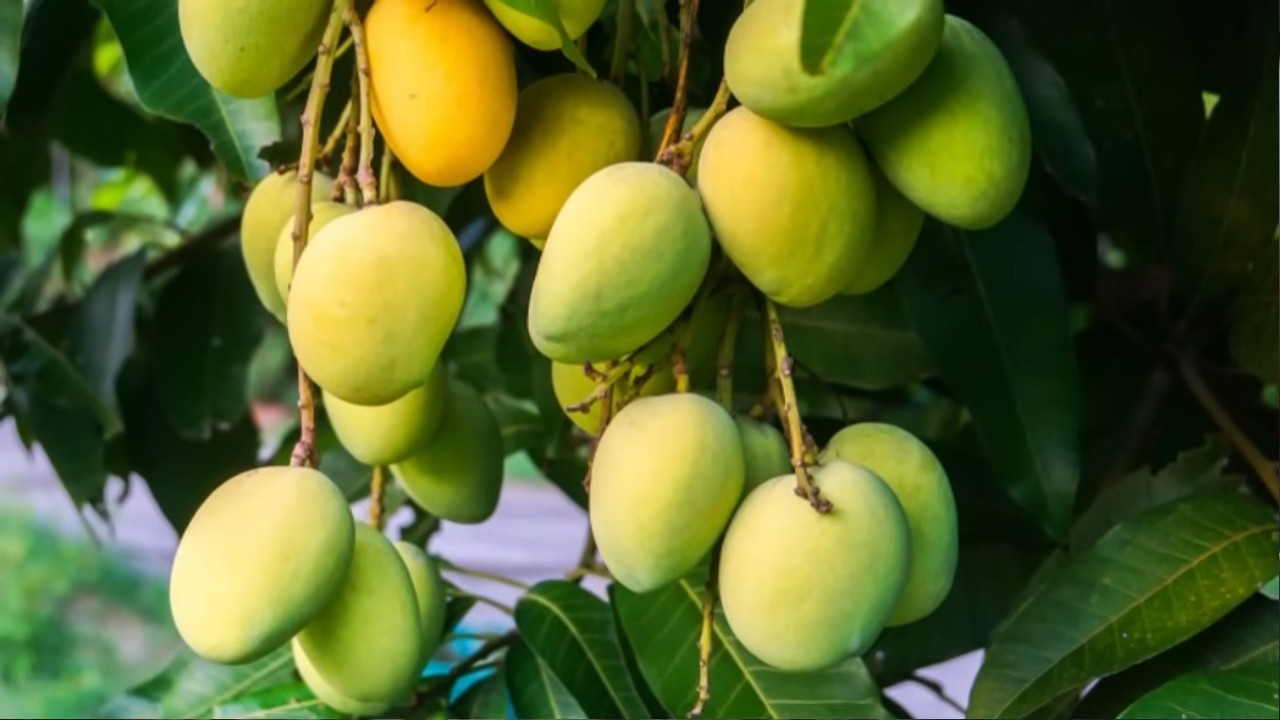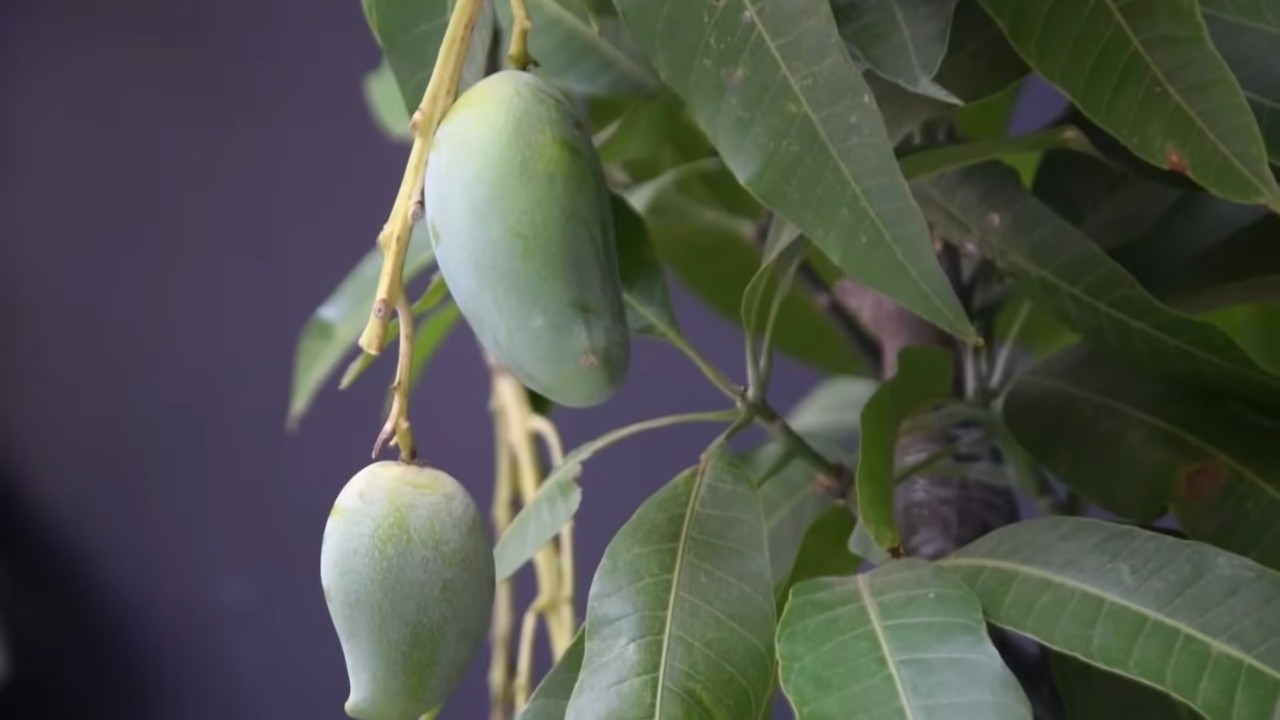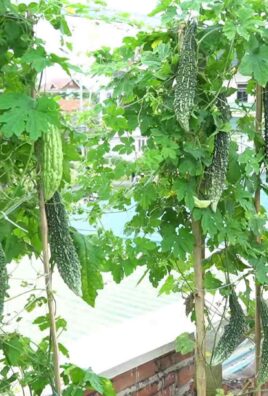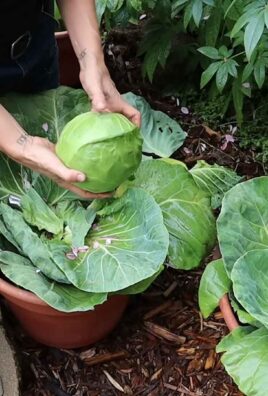Grow Mangoes at Home? Absolutely! Imagine plucking a juicy, sun-ripened mango straight from your own backyard. Sounds like a tropical dream, right? Well, it doesn’t have to be just a dream! This DIY guide is packed with simple, yet effective tricks to help you cultivate your very own mango oasis, no matter where you live.
Mangoes, often called the “king of fruits,” have a rich history dating back thousands of years in India. They’re deeply woven into the culture, symbolizing prosperity and good fortune. For centuries, cultivating mangoes was a skill passed down through generations. Now, I’m here to share some of that ancient wisdom, combined with modern techniques, to make growing mangoes accessible to everyone.
Why should you embark on this fruity adventure? Because store-bought mangoes, while delicious, often lack the intense flavor and freshness of homegrown ones. Plus, there’s nothing quite like the satisfaction of nurturing a plant from seedling to fruit-bearing tree. This DIY project is not only rewarding but also a sustainable way to enjoy one of the world’s most beloved fruits. So, let’s dive in and discover the secrets to successfully grow mangoes at home, transforming your garden into a tropical paradise!

Grow Your Own Delicious Mangoes: A DIY Guide
Okay, mango lovers, listen up! I’m going to walk you through everything you need to know to grow your own mango tree right at home. It might seem daunting, but trust me, with a little patience and the right steps, you’ll be enjoying homegrown mangoes before you know it.
Choosing Your Mango Variety
First things first, you need to decide what kind of mango you want to grow. This is important because some varieties are better suited for container growing than others, and some are more cold-hardy.
* Dwarf Varieties: These are your best bet for container growing. Look for varieties like ‘Nam Doc Mai’, ‘Cogshall’, ‘Julie’, or ‘Carrie’. They stay relatively small and manageable.
* Climate Considerations: Mangoes thrive in warm climates (USDA zones 9-11). If you live in a colder area, you’ll need to be prepared to bring your tree indoors during the winter.
* Taste Preference: Do you prefer sweet and tangy, or rich and creamy? Research different varieties to find one that suits your palate.
Getting Started: From Seed to Sapling (or Buying a Grafted Tree)
You have two main options here: growing from seed or buying a grafted tree. Growing from seed is fun and rewarding, but it takes longer (5-8 years to fruit) and the fruit might not be exactly like the parent mango. Grafted trees fruit much sooner (2-3 years) and you know exactly what kind of mango you’re getting.
Option 1: Growing from Seed
1. Choose a Ripe Mango: Select a fully ripe mango from a variety you like. The riper, the better!
2. Extract the Seed: Carefully cut open the mango and remove the seed. You’ll notice the seed is inside a husk.
3. Prepare the Seed: This is where it gets a little tricky. You need to carefully open the husk without damaging the seed inside. Use a sharp knife or pruning shears to gently pry it open. Be careful not to cut yourself! Inside, you’ll find a bean-shaped seed.
4. Germinate the Seed: Wrap the seed in a damp paper towel and place it in a plastic bag. Seal the bag and put it in a warm place (around 70-80°F or 21-27°C). Check the paper towel regularly and keep it moist.
5. Plant the Sprouted Seed: After a week or two, the seed should sprout. Once the sprout is a few inches long, it’s time to plant it in a pot. Use a well-draining potting mix and make sure the pot has drainage holes. Plant the seed with the sprout facing upwards.
6. Water and Care: Water the seedling regularly, keeping the soil moist but not soggy. Place it in a sunny location.
Option 2: Buying a Grafted Tree
This is the faster and more reliable option.
1. Choose a Reputable Nursery: Buy your grafted mango tree from a reputable nursery that specializes in fruit trees. This will ensure you’re getting a healthy, properly grafted tree.
2. Inspect the Tree: Look for a tree with healthy green leaves and a strong, well-developed root system. Avoid trees with signs of disease or pests.
3. Ask Questions: Don’t be afraid to ask the nursery staff about the specific variety you’re interested in and any special care requirements.
Planting Your Mango Tree
Whether you’re planting a seedling or a grafted tree, the process is similar.
1. Choose the Right Pot (for Container Growing): Select a large pot (at least 20 gallons) with drainage holes. Mango trees need plenty of room for their roots to grow.
2. Prepare the Potting Mix: Use a well-draining potting mix specifically formulated for fruit trees. You can also amend regular potting mix with perlite or vermiculite to improve drainage. I like to add some compost for extra nutrients.
3. Plant the Tree: Carefully remove the tree from its nursery pot and gently loosen the roots. Place the tree in the center of the new pot and fill in around it with potting mix. Make sure the top of the root ball is level with the soil surface.
4. Water Thoroughly: Water the tree thoroughly after planting to settle the soil.
Caring for Your Mango Tree
Now comes the ongoing care to keep your mango tree happy and healthy.
Sunlight
Mango trees need plenty of sunlight – at least 6-8 hours per day. Place your tree in the sunniest spot you can find. If you’re growing it indoors during the winter, supplement with a grow light.
Watering
Water your mango tree regularly, especially during the growing season (spring and summer). Allow the soil to dry out slightly between waterings. Overwatering can lead to root rot. In the winter, reduce watering frequency.
Fertilizing
Feed your mango tree with a balanced fertilizer specifically formulated for fruit trees. Follow the instructions on the fertilizer label. Fertilize regularly during the growing season. I like to use a slow-release fertilizer in the spring.
Pruning
Prune your mango tree regularly to maintain its shape and encourage fruit production. Remove any dead, damaged, or crossing branches. Prune in late winter or early spring, before new growth begins.
Pest and Disease Control
Keep an eye out for pests and diseases. Common pests include aphids, scale, and mealybugs. Treat infestations promptly with insecticidal soap or neem oil. Mango trees can also be susceptible to fungal diseases. Ensure good air circulation and avoid overwatering to prevent these problems.
Overwintering Your Mango Tree (If Necessary)
If you live in a colder climate, you’ll need to bring your mango tree indoors during the winter.
1. Prepare the Tree: Before bringing the tree indoors, inspect it for pests and diseases. Treat any problems you find.
2. Acclimatize the Tree: Gradually acclimatize the tree to indoor conditions by bringing it inside for a few hours each day, gradually increasing the time.
3. Provide Adequate Light: Place the tree in a sunny location or supplement with a grow light.
4. Water Sparingly: Reduce watering frequency during the winter.
5. Maintain Humidity: Indoor air can be dry during the winter. Increase humidity by misting the tree regularly or using a humidifier.
Encouraging Fruit Production
Getting your mango tree to fruit can sometimes be a challenge, especially in cooler climates. Here are a few tips:
* Ensure Adequate Sunlight: Mango trees need plenty of sunlight to produce fruit.
* Provide Proper Fertilization: Use a fertilizer that is high in phosphorus and potassium, which are essential for fruit development.
* Water Properly: Avoid overwatering or underwatering, as both can stress the tree and reduce fruit production.
* Protect from Frost: Mango flowers are sensitive to frost. If you live in an area with occasional frosts, protect your tree with a frost blanket.
* Hand Pollination (If Necessary): If you’re not seeing much fruit set, you can try hand-pollinating the flowers. Use a small paintbrush to transfer pollen from one flower to another.
Harvesting Your Mangoes
The moment you’ve been waiting for!
1. Look for Signs of Ripeness: Mangoes are typically ready to harvest when they change color and become slightly soft to the touch. They should also have a fragrant aroma.
2. Harvest Carefully: Use pruning shears to cut the mango from the tree, leaving a short stem attached.
3. Ripen Indoors: Mangoes can be ripened indoors at room temperature. Place them in a paper bag with a banana or apple to speed up the ripening process.
Troubleshooting
Even with the best care, you might encounter some problems along the way. Here are a few common issues and how to address them:
* Leaf Drop: Leaf drop can be caused by a variety of factors, including overwatering, underwatering, temperature stress, or pest infestations. Identify the cause and address it accordingly.
* Lack of Fruit: As mentioned earlier, lack of fruit can be due to insufficient sunlight, improper fertilization, or frost damage.
* Pest Infestations: Treat pest infestations promptly with insecticidal soap or neem oil.
* Fungal Diseases: Ensure good air circulation and avoid overwatering to prevent fungal diseases.
Enjoying Your Homegrown Mangoes
Congratulations! You’ve successfully grown your own mangoes. Now it’s time to enjoy the fruits of your labor. Eat them fresh, use them in smoothies, make mango salsa, or bake them into pies. The possibilities are endless!
Growing mangoes at home is a rewarding experience. It takes time and effort, but the taste of a homegrown mango is well worth it. So, get started today and enjoy the deliciousness of your own tropical paradise!

Conclusion
So, there you have it! Growing mangoes at home might seem like a tropical dream reserved for those with sprawling orchards, but with a little patience, the right techniques, and this simple DIY trick, you can absolutely cultivate your own delicious, sun-ripened mangoes, even in less-than-ideal climates. We’ve demystified the process, breaking down the steps to ensure success, from selecting the perfect seed to nurturing your young tree.
Why is this DIY approach a must-try? Because it empowers you to take control of your food source, reduces your reliance on commercially grown produce (often shipped long distances), and connects you with the natural world in a deeply satisfying way. Imagine the pride and joy of harvesting your very own mangoes, knowing you nurtured them from a single seed! Plus, homegrown mangoes often boast a superior flavor profile compared to store-bought varieties, bursting with sweetness and aroma that you simply can’t find elsewhere.
But the journey doesn’t end here! Feel free to experiment with different mango varieties to discover your personal favorite. Some popular choices for home growing include Tommy Atkins (known for its disease resistance), Haden (prized for its rich flavor), and Kent (a late-season variety perfect for extending your harvest). You can also explore different grafting techniques to potentially speed up the fruiting process and ensure the desired characteristics of your chosen variety. Consider using organic fertilizers and pest control methods to keep your mango tree healthy and thriving without harmful chemicals. Another variation is to try growing your mango tree in a large container, which allows you to move it indoors during colder months, further expanding your growing possibilities.
This DIY trick for growing mangoes at home is more than just a gardening project; it’s an investment in your well-being, a connection to nature, and a source of delicious, homegrown fruit. Don’t be intimidated by the perceived complexity. Start small, follow our guide, and embrace the learning process. The rewards are well worth the effort.
We are incredibly excited for you to embark on this mango-growing adventure! We encourage you to try this DIY trick and share your experiences with us. Post photos of your seedlings, document your progress, and let us know what challenges you encounter and how you overcome them. Your insights will not only inspire others but also contribute to a collective knowledge base that benefits the entire community of home mango growers. Let’s cultivate a community of thriving mango trees, one seed at a time! Share your success stories and any variations you try in the comments below. We can’t wait to see your homegrown mangoes!
Frequently Asked Questions (FAQ)
Q: What is the best time of year to start growing mangoes from seed?
A: The ideal time to start growing mangoes from seed is during the late spring or early summer. This allows the seedling to benefit from the warm temperatures and longer daylight hours, which are crucial for healthy growth. Starting in these months gives the young plant ample time to establish itself before the onset of colder weather. However, if you live in a tropical or subtropical climate with consistently warm temperatures, you can technically start the process at any time of year. Just be mindful of providing adequate warmth and sunlight, especially during the cooler months.
Q: How long does it take for a mango tree grown from seed to produce fruit?
A: Patience is key! Mango trees grown from seed typically take anywhere from 5 to 8 years to produce fruit. This is because the tree needs to mature sufficiently before it can allocate resources to fruit production. Grafted mango trees, on the other hand, can start bearing fruit much sooner, often within 2 to 4 years. If you’re looking for a quicker harvest, consider purchasing a grafted mango tree from a reputable nursery. However, growing from seed is a rewarding experience in itself, allowing you to witness the entire life cycle of the tree.
Q: What kind of soil is best for growing mangoes?
A: Mango trees thrive in well-draining soil that is rich in organic matter. A slightly acidic to neutral pH (around 6.0 to 7.0) is ideal. Avoid heavy clay soils that retain too much water, as this can lead to root rot. Amend your soil with compost, well-rotted manure, or other organic materials to improve drainage and fertility. When planting in containers, use a high-quality potting mix specifically formulated for fruit trees.
Q: How much sunlight do mango trees need?
A: Mango trees are sun-loving plants and require at least 6 to 8 hours of direct sunlight per day to thrive. Choose a planting location that receives ample sunlight throughout the day. If you’re growing your mango tree in a container, make sure to place it in a sunny spot, such as a south-facing balcony or patio. Insufficient sunlight can lead to stunted growth, reduced fruit production, and increased susceptibility to diseases.
Q: How often should I water my mango tree?
A: Watering frequency depends on several factors, including the age of the tree, the climate, and the type of soil. Young mango trees need more frequent watering than mature trees. In general, water deeply whenever the top inch of soil feels dry to the touch. Avoid overwatering, as this can lead to root rot. During the dry season, you may need to water more frequently. Mulching around the base of the tree can help retain moisture in the soil.
Q: What are some common pests and diseases that affect mango trees?
A: Mango trees can be susceptible to various pests and diseases, including mango hoppers, fruit flies, scales, anthracnose, and powdery mildew. Regularly inspect your tree for signs of infestation or disease. Use organic pest control methods, such as neem oil or insecticidal soap, to control pests. Prune away any diseased or damaged branches. Ensure good air circulation around the tree to prevent fungal diseases.
Q: Can I grow a mango tree indoors?
A: While it’s possible to start a mango tree indoors, it can be challenging to provide the tree with the optimal conditions it needs to thrive long-term. Mango trees require a lot of sunlight and space, which can be difficult to provide indoors. If you choose to grow a mango tree indoors, select a dwarf variety and provide it with as much sunlight as possible. You may also need to supplement with artificial lighting. Be prepared to eventually transplant the tree outdoors or into a very large container as it grows.
Q: How do I prune my mango tree?
A: Pruning is essential for maintaining the health and shape of your mango tree. Prune during the dormant season (late winter or early spring) to remove any dead, damaged, or crossing branches. Prune to create an open canopy that allows sunlight to penetrate throughout the tree. You can also prune to control the size and shape of the tree. Avoid pruning heavily, as this can reduce fruit production.
Q: What kind of fertilizer should I use for my mango tree?
A: Mango trees benefit from regular fertilization, especially during the growing season. Use a balanced fertilizer specifically formulated for fruit trees. Look for a fertilizer with a higher phosphorus content to promote flowering and fruit production. Follow the instructions on the fertilizer label carefully. Avoid over-fertilizing, as this can damage the tree. You can also supplement with organic fertilizers, such as compost or well-rotted manure.
Q: How do I know when my mangoes are ripe?
A: Determining when a mango is ripe can be tricky, as the color of the skin is not always a reliable indicator. Look for mangoes that are slightly soft to the touch and have a fragrant aroma near the stem end. The skin may also develop a slight blush or change in color, depending on the variety. Gently tug on the mango; if it comes off the tree easily, it’s likely ripe. Avoid squeezing the mangoes too hard, as this can bruise them.





Leave a Comment